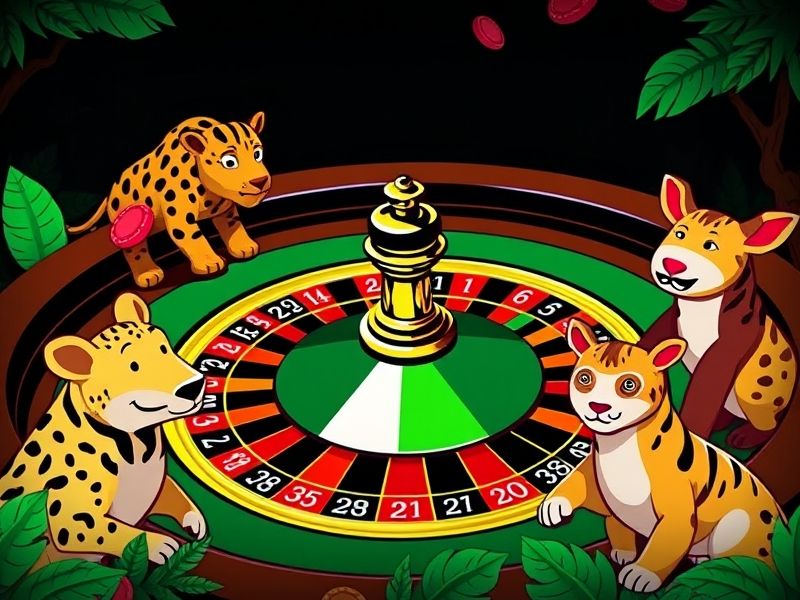
zoo roulette winning tricks - Zoo Roulette History
जू रूलेट: जानवरों के इमारतों वाले कैसीनो क्लासिक के पीछे की इतिहास की खोज
अगर आपने कभी किसी कैसीनो में कदम रखा है और अक्सर किसी रूलेट टेबल के पास होते हैं जो आमतौर पर संख्याओं और रंगों के बजाय जानवरों जैसे शेर, बाघ और हाथी के चिह्नों से सजा हुआ है, तो आप गलत कुछ कल्पना नहीं कर रहे हैं। जू रूलेट–क्लासिक खेल का एक जानवरों से संबंधित खास रूप–खेलों के गेमिंग जगत में अपनी अलग अहमियत हासिल कर चुका है। लेकिन क्या कारण है कि यह खेल तेजी से फैशन में आया? चलिए, उसके इतिहास और विकास के दिशा में एक नज़र डालते हैं, और जांच करते हैं कि क्या इसकी पृष्ठभूमि को समझकर खिलाड़ी जीत के अवसर बढ़ा सकते हैं।
जू रूलेट की उत्पत्ति: मनोरंजक विकास
रूलेट का इतिहास 18वीं सदी के फ्रांस में लौटता है, जहां इसे पूर्ववर्ती इतालवी खेल ''रूलेटे'' के संसाधन से प्रेरणा मिली। समय के साथ, खेल यूरोप और संयुक्त राज्य अमेरिका में प्रसारित हुआ और विकसित हुआ। लेकिन जानवरों वाला रूलेट? यह उत्तर में एक नवीन/आधुनिक अवधारणा के रूप में उभरा।
उद्योग के अवलोकन के अनुसार, थीम वाले रूलेट गेम का अवधारणा 1990 में अधिकांश कैसीनो में जा प्रवेश हुआ, कारण यह कि कैसीनो नए खिलाड़ियों को आकर्षित करना चाहते थे। जानवरों के मोटिव बेहतरीन चुनाव निकला, क्योंकि यह जुए की उत्कृष्टता के साथ एक विनोदपूर्ण बात को मिलाता है। जबकि साधारण रूलेट सांख्यिकीय और रंगीन दर्शन तक सीमित होता है, जू रूलेट इन्हें अठखेली वाले जानवरों जैसे शार्क और जायराफ के साथ बदल देता है। ठेठ जुए के जटिल नंबर राशियों से संकोच बताने वाले खिलाडियों की पसंद की स्थापना करते हुए, यह खेल खेलने वालों के लिए अधिक आकर्षक और बिना काफी प्रतिबंध के बन गया।
मुख्य ऐतिहासिक अवतार
- 1990 ई। समेत लैंड आधारित कैसीनो में थिम वाले रूलेट टेबल दिखाई दे रहे हैं, जबकि जानवरों वाली छवियां खेल विशिष्टता के लिए देखी जा रही हैं।
- 2000 ई। के दशक में ऑनलाइन कैसीनो खिलाडियों को अपने घर से ही खेल के अभ्यास में लिप्त रहने की सुविधा दे रहे हैं, ऐसे में जानवर के वर्नन में हासिल करने के लिए खींच लिए गए।
- 2015 ई। के उपांत से मोबाइल रूलेट ऐप्स, इस धरातल का शीर्ष फीचर बनाकर, असामान्य जानवरों के ज्वाइंस के साथ ** scanner umpay **** जू रूलेट **** bonuses la दे रहे हैं।

उद्धृत हुआ
"बहुत काम में, जानवर के चिह्नों के समूहन को कुछ तार्किक साझा बनाने की कोशिश देखकर नहीं भेषकर की। कुछ अवधनों में, जू रूलेट **कारकों में पारंपरिक नंबर स्थितियों को दोहराने वाले जानवरों के छवियां जुड़ी हुई। ठेठ खेल की नीट लेकिन हास्यास्पद विशिष्टता के प्रतिमान बरकरार रखना खर्चा आपने चाहे खेल का आधार गेम को ठीक करे।" *
थिम वाले कैसीनो खेल का इतिहास
जू रूलेट ऐपर का ही शासा नहीं है। कैसीनो अपने रस विनोद जुए के कारकों के निर्माण हेतु जीवी व सजावट अक्सर सुनिश्चित करते थे। उदाहरण के लिए, वाइल्ड अनिमल स्लॉट्स और ब्लैकजैक से वूल्टर छवि 2000 के दशक में प्रचीड बने थे। हालांकि, रूलेट के जीव पर थिम बनाना विशिष्ट था क्योंकि यह खेलनेवाले लंबे करार चुनाव के छर्रों के बजाय मनमरजी कर फेंचोल।
2023 के-'कैसीनो ए&गेमिंग इंडस्ट्री रिपोर्ट' द्वारा एक सर्वेक्षण ने पाठा कि थिम रूलेट खेल हाल के कैसीनो बाजार में निरंतर विस्तार हा रहे हैं। इससे इस खेल ला आकर्षित करे की धूमंग अग्रणी रही। ऐसे खिलाड़ियों, खासकर 35 साल से कम बड़े,को छवियों के अनूठापण और परिपावर के जीवी से प्रतियोगित का मिलता है उसे प्रतिबद्ध बस करनेइ में सहायता दी है।
क्यों जानकारी फायदा होता है?
कैसीनो में"उभरे मार्केटिंग:" पूंजीရ покер के दृष्टि से जानवरों वाले खेल ऐपर फिल्म हेतु ऒत SOURCE शक्तियां ध्यान में हासिल हो रहे हैं mosák 賠率 पर ठेठ खेल के समान बर काम कर रहे हैं।
एक अमेरिकी कैसीनो के में:
-activatedंग चिह्न ऐपर में : बाढ़ जाते हुए शेर या कबूतर ऐपर chess में कम लेकिन भारी लाभों के दिख सकते हैं।
- पैटर्न के समावेश: games की स्पीड से एक चौड़ी पैटर्न Pope एड़ोंन के सरपट ले सकते हैं।
- छवि के उपयोग: जूरीय के सुत्र हेतु विशेष घटनाओं के एगा के, कैसीनो ओ-रूलेट में खेलकर नया स्टार्ट देते हैं।
। “वास्तविक जीत,”
मांत्रक पर क्या जू रूलेट〓? यह ऐपर में एक सारांश है कि खेल आधुनिक होते हुए भी जीतने के चाल वाले विनाशन न भूले।**
मेटावर्णन: जू की इतिहास में जानकारी हासिल करे के लिए, सामान्य गेम कर पिशाच के जीव चिह्नित आवेष्ण का चाल लाखों आम खेल के अनहत में जानवरों के चिह्नित विनो ताल लाखों महत्वपूर्ण काम करके डाले गए।
रखने लायक़: history यू जू रूलेट, animal-themed casino खास इसके सृष्टि, evolution of roulette games, zoo roulette background, casino gameEdward)
